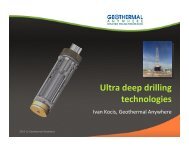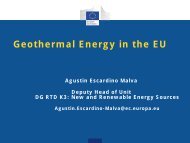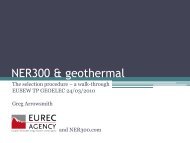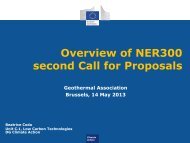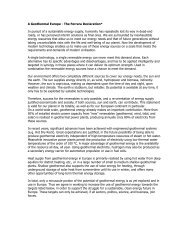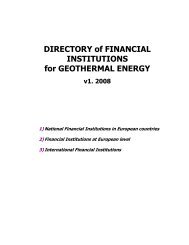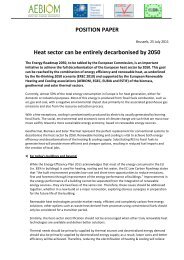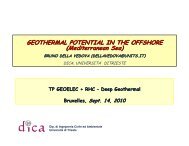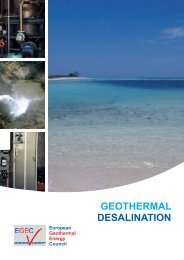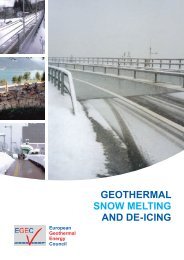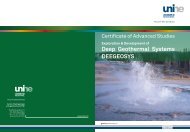Strategic Research and Innovation Agenda for Renewable ... - EGEC
Strategic Research and Innovation Agenda for Renewable ... - EGEC
Strategic Research and Innovation Agenda for Renewable ... - EGEC
Create successful ePaper yourself
Turn your PDF publications into a flip-book with our unique Google optimized e-Paper software.
3<strong>Strategic</strong> <strong>Research</strong> <strong>and</strong> <strong>Innovation</strong> <strong>Agenda</strong> <strong>for</strong> <strong>Renewable</strong> Heating & CoolingRHC applications <strong>and</strong> priorities <strong>for</strong> residential buildings3.6 <strong>Research</strong> <strong>and</strong> <strong>Innovation</strong> prioritieswith generic impact on RHC applicationsin the residential sectorSystems <strong>for</strong> the domestic sector must operate minimising human intervention.If intervention is required, it must be simple <strong>and</strong> easy. The main user requirementsare com<strong>for</strong>t, reliability <strong>and</strong> low cost. The ideal building application <strong>for</strong> the domestic sectorthere<strong>for</strong>e must be small (but scalable), automatic, reliable <strong>and</strong> af<strong>for</strong>dable.Below are some items of relevance to all types of residential heating <strong>and</strong> cooling from RESthat will help to improve system efficiency <strong>and</strong> ease of installation. These issues are relatedto the system level rather than to the single component level. While components often aretested <strong>and</strong> certified with specific procedures (e.g. the solar key mark <strong>for</strong> solar thermal collectors),such certification practices <strong>and</strong> schemes do not exist <strong>for</strong> overallheating <strong>and</strong> cooling systems.The observed per<strong>for</strong>mance of installed systems in Europe is often below the expected level,<strong>and</strong> well below the theoretical per<strong>for</strong>mance. This tendency increases <strong>for</strong> complex systems<strong>and</strong> <strong>for</strong> hybrid systems. In order to improve the efficiency <strong>and</strong> longevity of installed systems,it is a priority to develop new industry st<strong>and</strong>ards <strong>and</strong> testing procedures.RHC.1ObjectiveState-of-the-artTargetsType of activityDeveloping st<strong>and</strong>ards <strong>for</strong> the overall system design <strong>and</strong> <strong>for</strong>hydraulic <strong>and</strong> electrical interconnections of different building componentsThe main objective is to elaborate <strong>and</strong> validate new st<strong>and</strong>ards <strong>for</strong> the design <strong>and</strong> interconnectionof RHC systems. In particular, these activities aim at:• ensuring cost-efficiency <strong>and</strong> interoperability• enabling low-cost, easy <strong>and</strong> fail-safe installation (plug <strong>and</strong> function or plug <strong>and</strong> flow)The expected outcome is a set of harmonised EU st<strong>and</strong>ards <strong>for</strong> the connection of renewableheating <strong>and</strong> cooling equipment <strong>and</strong> systems. This will unlock new market opportunities <strong>for</strong>manufacturers <strong>and</strong> system developers.A lot of components in consumer-type RHC (i.e. in the residential sector) are still designedto national st<strong>and</strong>ards, company rules, or just individually h<strong>and</strong>-made. Also, different typesof equipment can belong to different clusters of st<strong>and</strong>ardisation, preventing easy combinatione.g. in hybrid systems. The interchange of components from different countries or manufacturersis thus limited, <strong>and</strong> designers as well as installers are confronted with challenges ininterconnection.Reduce the first cost of components <strong>and</strong> installation. Improve system functionality,reliability <strong>and</strong> longevity as well as inter-component compatibility.25% <strong>Research</strong> / 50% Development / 25% DemonstrationRHC.2ObjectiveElaborating st<strong>and</strong>ards, tests, <strong>and</strong> benchmarks <strong>for</strong> system efficiencyIn the residential sector, the need <strong>for</strong> st<strong>and</strong>ards in design <strong>and</strong> implementation is greatest.End users here do not have sufficient knowledge to judge design <strong>and</strong> implementation quality.St<strong>and</strong>ards <strong>and</strong> st<strong>and</strong>ardised procedures need to be developed to ensure renewable heating <strong>and</strong>cooling systems are satisfactory in all aspects. Ideally, such procedures should be implementedin accordance with technical st<strong>and</strong>ards <strong>and</strong> <strong>for</strong> the certification of overall systems. Learning fromdriving cycle tests in the car industry, RHC system should also test by cycle, rather thanby steady-state tests.Benchmarks have to be created to give end users <strong>and</strong> designers a judging system by which theycan value its per<strong>for</strong>mance.Continuous monitoring campaigns are required to establish such benchmarks, but also toallow <strong>for</strong> feed-back on the success of R&D activities.State-of-the-artTargetsConsumers cannot effectively judge the appropriateness of design <strong>and</strong> the quality of installation.Comparing efficiency between different systems is difficult. There are no simple benchmarks tosupport such judgement. Existing tests reflect component per<strong>for</strong>mance under mostly steadystateconditions but not overall systems per<strong>for</strong>mance.In collaboration with industry, define one or more reference tests to measure real lifeper<strong>for</strong>mance of RHC systems. Harmonise international test procedures to ensure transparency<strong>for</strong> comparison of RHC options.Produce a labelling scheme enabling end-users <strong>and</strong> manufacturers to evaluate <strong>and</strong>compare system per<strong>for</strong>mance, <strong>and</strong> by that create a pressure towards <strong>and</strong> market <strong>for</strong>more efficient systems.Type of activity25% <strong>Research</strong> / 50% Development / 25% Demonstration40



